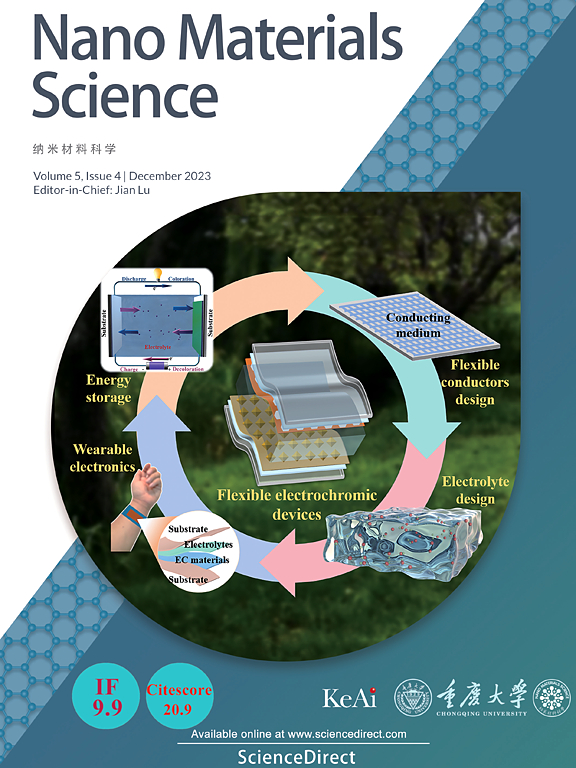高性能超级电容器用多孔高导电性PEDOT薄膜
IF 17.9
2区 材料科学
Q1 Engineering
引用次数: 0
摘要
厚而高导电性的聚(3,4-乙烯二氧噻吩)-聚苯乙烯磺酸膜具有理想的多孔结构,可以作为超级电容器的电极。然而,由于主要的PSS成分固有的柔软性,没有模板或复合材料的帮助,均匀的微观结构存在很大的障碍。在这项研究中,我们成功地利用乙二醇(EG)作为溶剂的溶剂热方法开发了多孔结构。通过去除不导电的PSS链,提高PEDOT结晶度,形成多孔网络,压力和温度的协同作用对EG调整PEDOT:PSS膜的微观结构至关重要。所得到的多孔PEDOT:PSS薄膜具有1644 S cm−1的高电导率,并实现了270 F cm−3的体积电容记录,显着超过了先前的记录。该薄膜组装的柔性全固态超级电容器具有97.8 F cm−3的体积电容和8.7 mWh cm−3的能量密度,是纯PEDOT: pss超级电容器的最佳材料。采用掠入射广角x射线散射、x射线光电子能谱等表征方法对其结构演化进行表征。本研究为导电聚合物形态控制提供了有效的新方法,促进了PEDOT:PSS在储能领域的应用。本文章由计算机程序翻译,如有差异,请以英文原文为准。
Porous highly conductive PEDOT film for high-performance supercapacitors
Thick and highly conductive poly(3,4-ethylenedioxythiophene)-polystyrene sulfonate films with ideal porous structure are fulfilling as electrodes for supercapacitors. However, the homogeneous micro-structure without the aid of templates or composite presents a significant obstacle, due to the intrinsic softness of the dominant PSS component. In this study, we have successfully developed a porous configuration by employing a solvothermal approach with ethylene glycol (EG) as the solvent. The synergistic action of elevated pressure and temperature was crucial in prompting EG to tailor the microstructure of the PEDOT:PSS films by removing non-conductive PSS chains and improving PEDOT crystallinity, and the formation of a porous network. The resulting porous PEDOT:PSS films exhibited a high conductivity of 1644 S cm−1 and achieved a volumetric capacitance record of 270 F cm−3, markedly exceeding previous records. The flexible all-solid-state supercapacitor assembled by the films had an outstanding volumetric capacitance of 97.8 F cm−3 and an energy density of 8.7 mWh cm−3, which is best one for pure PEDOT:PSS-based supercapacitors. Grazing-incidence wide-angle X-ray scattering, X-ray photo-electron spectroscopy, and other characterizations were carried out to characterize the structure evolution. This work offers an effective novel method for conducting polymer morphology control and promotes PEDOT:PSS applications in energy storage field.
求助全文
通过发布文献求助,成功后即可免费获取论文全文。
去求助
来源期刊

Nano Materials Science
Engineering-Mechanics of Materials
CiteScore
20.90
自引率
3.00%
发文量
294
审稿时长
9 weeks
期刊介绍:
Nano Materials Science (NMS) is an international and interdisciplinary, open access, scholarly journal. NMS publishes peer-reviewed original articles and reviews on nanoscale material science and nanometer devices, with topics encompassing preparation and processing; high-throughput characterization; material performance evaluation and application of material characteristics such as the microstructure and properties of one-dimensional, two-dimensional, and three-dimensional nanostructured and nanofunctional materials; design, preparation, and processing techniques; and performance evaluation technology and nanometer device applications.
 求助内容:
求助内容: 应助结果提醒方式:
应助结果提醒方式:


